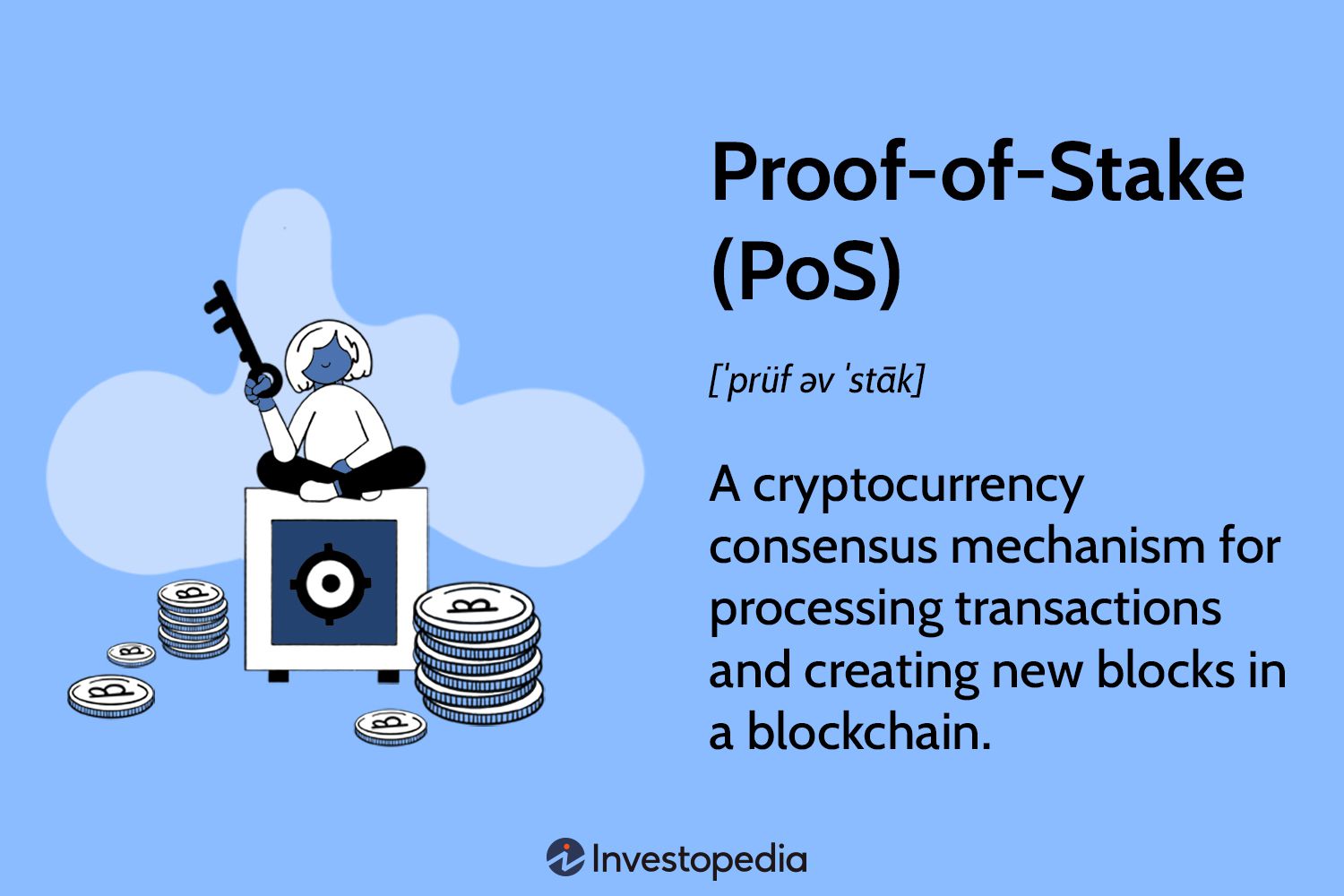 What Is Proof-of-Stake (PoS)?
What Is Proof-of-Stake (PoS)?
Proof-of-stake is a cryptocurrency consensus mechanism for processing transactions and creating new blocks in a blockchain.A consensus mechanism is a method for validating entries into a distributed database and keeping the database secure.In the case of cryptocurrency, the database is called a blockchain—so the consensus mechanism secures the blockchain.
Learn more about proof-of-stake and how it is different from proof-of-work.Additionally, find out the issues proof-of-stake attempts to address within the cryptocurrency industry.
Key Takeaways
– Under proof-of-stake (POS), validators are chosen based on the number of staked coins they have.
– Proof-of-stake (POS) was created as an alternative to proof-of-work (POW), the original consensus mechanism used to validate transactions and open new blocks.
– While PoW mechanisms require miners to solve cryptographic puzzles, PoS mechanisms require validators to hold and stake tokens for the privilege of earning transaction fees.
– Proof-of-stake (POS) is seen as less risky regarding the potential for an attack on the network, as it structures compensation in a way that makes an attack less advantageous.
– The next block writer on the blockchain is selected at random, with higher odds being assigned to nodes with larger stake positions.
Click Play to Learn All About Proof-of-Stake
Understanding Proof-of-Stake (PoS)
Proof-of-stake reduces the amount of computational work needed to verify blocks and transactions.Under proof-of-work, hefty computing requirements kept the
blockchain secure.Proof-of-stake changes the way blocks are verified using the machines of coin owners, so there doesn’t need to be as much computational work done.The owners offer their coins as collateral—staking—for the chance to validate blocks and earn rewards.
Validators are selected randomly to confirm transactions and validate block information.
This system randomizes who gets to collect fees rather than using a competitive rewards-based mechanism like proof-of-work.
To become a validator, a coin owner must “stake” a specific amount of coins.For instance,
Ethereum requires 32 ETH to be staked before a user can operate a node.Blocks are validated by multiple validators, and when a specific number of validators verify that the block is accurate, it is finalized and closed.
To activate your own validator, you’ll need to stake 32 ETH; however, you don’t need to stake that much ETH to participate in validation.You can join validation pools using “liquid staking” which uses an ERC-20 token that represents your ETH.
Different proof-of-stake mechanisms may use various methods to reach a consensus.For example, when Ethereum introduces sharding, a validator will verify the transactions and add them to a shard block, which requires no more than 128 validators to form a voting “committee.” Once shards are validated and a block created, two-thirds of the validators must agree that the transaction is valid, then the block is closed.
How Is Proof-of-Stake Different From Proof-of-Work?
Both consensus mechanisms help blockchains synchronize data, validate information, and process transactions.Each method has proven successful at maintaining a blockchain, although each has pros and cons.However, the two algorithms have very different approaches.
Under PoS, block creators are called validators.
A validator checks transactions, verifies activity, votes on outcomes, and maintains records.Under PoW, block creators are called miners.
Miners work to solve for the hash, a cryptographic number, to verify transactions.In return for solving the hash, they are rewarded with a coin.
To “buy into” the position of becoming a block creator, you need to own enough coins or tokens to become a validator on a PoS blockchain.For PoW, miners must invest in processing equipment and incur hefty energy charges to power the machines attempting to solve the computations.
The equipment and energy costs under PoW mechanisms are expensive, limiting access to mining and strengthening the security of the blockchain.PoS blockchains reduce the amount of processing power needed to validate block information and transactions.The mechanism also lowers network congestion and removes the rewards-based incentive PoW blockchains have.
editorial policy.
Ethereum.”
Proof-of-Stake (PoS).”
Ethereum.org.”
Staking With Ethereum.”
Github.”
Ethereum | Consensus Specs.”
University of Cambridge.
“
Cambridge Bitcoin Electricity Consumption Index.”
Digiconomist.”
Ethereum Energy Consumption Index.”
Cointelegraph.”
The History and Evolution of Proof-of-Stake.”
Ethereum.”
Get Involved in ETH2.”
–
Altcoin Explained: Pros and Cons, Types, and Future
–
10 Important Cryptocurrencies Other Than Bitcoin
–
Gas (Ethereum): How Gas Fees Work on the Ethereum Blockchain
–
What Does Proof-of-Stake (PoS) Mean in Crypto?
–
What Are Crypto Tokens, and How Do They Work?
–
Stablecoins: Definition, How They Work, and Types
–
HODL: The Cryptocurrency Strategy of “Hold on for Dear Life” Explained
–
Binance Exchange
–
ICON
–
Shitcoin
–
Tether (USDT): Meaning and Uses for Tethering Crypto Explained
–
Cryptocurrency Dogecoin (DOGE): What It Is, History, Uses
–
Binance Coin (BNB) Uses, Support, and Market Cap
–
Litecoin (LTC): What It Is, How It Works, Vs.
Bitcoin
–
Ripple
–
Tezos (XTZ): Definition and How It Works in Crypto
–
Cardano (ADA): What It Is, How It Differs from Bitcoin
–
Best Crypto Exchanges of 2023
–
Binance vs.Coinbase
–
Coinbase vs.Robinhood
–
coinbase vs coinbase pro
–
eToro vs.Coinbase
–
Gemini vs.Coinbase
–
Kraken vs.Coinbase
–
How to Buy Ripple (XRP).
